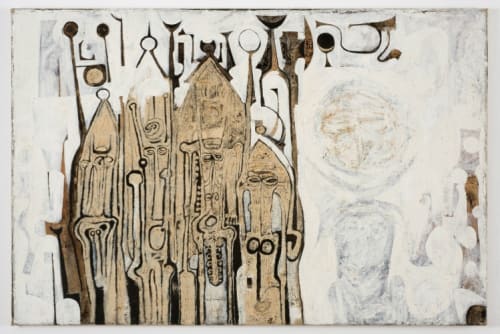29 May – 31 July 2015
Two years since his solo show at Tate Modern, Ibrahim El-Salahi — one of Sudan’s foremost living artists—and his elegant, visionary paintings and drawings are back. The pioneering artist was the first from his continent to be represented in a retrospective at Tate Modern, and this spring, thanks to Vigo Gallery, his works will be on view in New York, London, Hastings, and Istanbul.
Though his approach to his work is decidedly personal, El-Salahi’s compositions beautifully reflect the internationalism of our times. He merges European abstraction, the traditions of Arabic calligraphy and ornamentation, the colors and crafts of his native Sudan, and his own life experiences to develop striking works that range in scope from celebrations of culture to statements on social injustice.
El-Salahi is the focus of Vigo Gallery’s booth at Frieze New York this year. On show will be works drawn from the artist’s own archives, including rare paintings and drawings from the 1960s, and monumental, multi-part compositions from the 1980s and 90s. Among these is the edgy Visual Diary of a Time-Waste Palace (1996), whose genesis is as intriguing as its semi-abstract, ink-on-paper images. The artist made this work while serving as an advisor to the Qatari government and a translator and cultural advisor to the Emir. These roles gave him access to the Emir’s palace, where he found square-shaped, blank books. For a year and a half, he worked to fill each page of these books with drawings, ultimately creating the 57 drawings of Time-Waste Palace. Upon completion (and at the age of 66), he decided to devote the rest of his life to art making full-time.
Later this month, at Vigo’s Mayfair space, a suite of paintings that were featured prominently in the Tate retrospective receive a renewed exhibition. As the title, Flamenco, may suggest, the series is the result of the artist’s travels through southern Spain in 2009, during a trip with the collector AbdulMagid Breish. During that summer, El-Salahi experienced Marbella, Toledo, Córdoba, Granada, and Málaga, exploring the cities’ Moorish architecture by day, and enjoying traditional food and dance at night. He was particularly inspired by the Alhambra in Granada, where he found motifs that were the same as ones he encountered while studying the Quran during his youth. The resulting paintings are spirited, rhythmic compositions in black and white or rich umber and sepia tones, filled with stylized dancers that range from curvaceous abstract forms to robust, defined figures in traditional costume.
The artist’s spirit of independence and individuality finds its reflection in a tree native to his country, which has inspired him for decades: the Haraza. This tree is the focus of a series of subtle, modernist drawings, which are now on view in a concentrated exhibition at the Jerwood Gallery, presented in partnership with Vigo Gallery. Bucking all expectations, the Haraza flourishes in the dry season and sheds its leaves during the wet season, when everything else is in bloom. “This is a definitive statement,” El-Salahi once declared about his beloved Haraza. “Like saying, ‘I am me! I am an individual! I do not follow what everyone is doing! When everyone is going to be green, let them be green. I am not! It’s individuality. I love that very much.”


